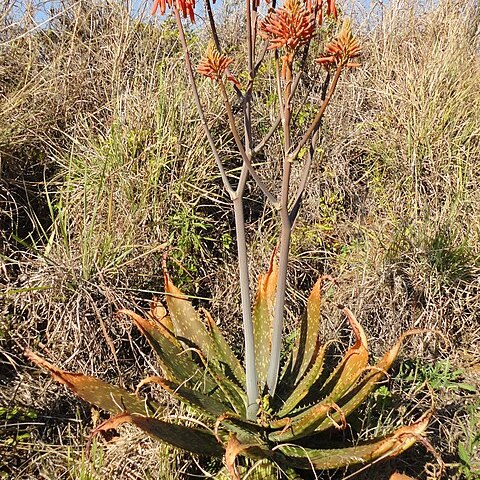Plants usually stemless, sometimes short-stemmed in old, robust plants; 150-300 mm tall excluding inflorescence; usually solitary. Leaves ±12 per rosette, 160-470 x 60-120 mm, upper surface channelled, dark green with many pale spots in irregular transverse bands, lower surface convex, pale green, lineate. Inflorescence with 3-8 ultimate branches, 1.0-1.75 m tall; racemes capitate to subcapitate, dense; bracts narrowly deltoid-acuminate, 10-20 x 2-4 mm, 3-many-nerved. Flowers dull flesh-pink to almost white, often with paler longitudinal stripes, 22-35 mm long, subclavate above basal constriction; outer segments free for 7-10 mm, inner segments adnate to outer; pedicels 12-25 mm long, length-ening to +30 mm in fruit. Anthers exserted 1-2 mm. Ovary 5.0-7.0 x 1.5-3.0 mm, green; style exserted 2-3 mm. Fruit 19-32 x 9-15 mm, pink-ish grey. Seeds deep grey-maroon, ±4.0 x 2.5 x 1.0 mm, wing small to absent.
Leaves in a compact rosette, spreading; lamina 20–40 × 6–12 cm, broadly lanceolate, usually dried and twisted in the apical 5–15 cm, dull greyish-green, with conspicuous elongated whitish spots arranged in irregular transverse bands on the upper surface, pale greyish-green and unspotted on the lower surface, lineate especially near the margins; margin horny and often brownish with pungent deltoid red-brown teeth 4–6 mm long and 10–15 mm apart; sap drying yellow.
An evergreen succulent plant. The leaves can be 40 cm long. The leaves have a reddish-brown to deep green upper surface. There are reddish teeth along the edge. There can be 2 or 3 flower stalks from one ring of leaves. The flower stalk can be 1.4 m long. The flower heads are 20 cm long. The fresh buds are pink. The flowers have white stripes. Plants sucker and grow in groups.
Perianth pale pink, with paler margins to the segments running to the base of the perianth, 25–32 mm long, 7–8 mm in diameter across the ovary, constricted just above the ovary, then widening and becoming slightly decurved towards the mouth, cylindric-trigonous; outer segments free for more than one-third, scarcely spreading at the tips.
Inflorescences 1–3, erect, 1.25–1.75 m high; peduncle sturdy, 3–10-branched, the lowest branches sometimes rebranched; branches suberect, subtended by deltoid, scarious, many-nerved bracts 2–3 cm long.
Perennial herb, solitary or suckering to form small groups of plants, acaulescent or with a stout stem to 30 cm tall covered with dead leaf remains.
Racemes 8–20 × 7 cm, conical-cylindric, ± densely flowered; bracts 10–15 mm long, linear-lanceolate, scarious; pedicels 12–18 mm long.
Stamens and stigma scarcely exserted.
Capsule and seeds not seen.


